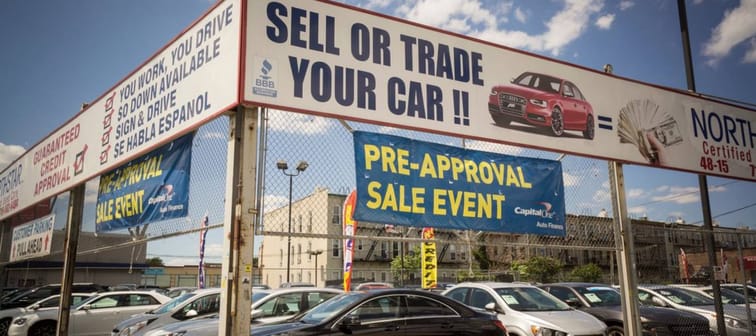Cover fixed expenses first
Olivier Boyd, a licensed insolvency trustee at Canadian professional accounting firm MNP, says you first must prioritize fixed expenses.
“You should be able to make ends meet and make sure all your other fixed expenses are covered,” Boyd advises. “Anything above that, then you're entering a territory where it's probably going to be that you have to be sacrificing something else.”
In addition to using common sense, the general wisdom is that people should budget 10% to 20% of their gross pay for their vehicle each year.
For example, a person making $30,000 a year should probably budget no more than $400 a month after deductions and taxes, and factoring in the insurance, Boyd says.
While this “rule of thumb” can be applied everywhere, it could change in an urban setting where housing costs could possibly take up to 50% to 60% of one’s income. This situation would make getting a car a less wise option, he says.
This sentiment is shared by Brian P. Doyle, president and co-founder of Canadian insolvency firm Doyle Salewski Inc.
Doyle describes himself as a “pessimist” since he expects a lingering “major recession.” People who live in urban areas with enhanced public transportation are better off getting rid of the car expense when possible, Doyle says.
More: Stop overpaying for car insurance today
Discover how a simple decision today could lead to an extra $1.3 million in retirement
Learn how you can set yourself up for a more prosperous future by exploring why so many people who work with financial advisors retire with more wealth.
Discover the full story and see how you could be on the path to an extra $1.3 million in retirement.
Read MoreBudget for unexpected expenses
Getting an auto loan also means factoring in interest rates and your credit score, determining the impact that these cumulative expenses will have on your budget.
Doyle also emphasizes the importance of leaving some money for unexpected expenses in case of the “wheels coming off.” This emergency stash is highly recommended for people with older cars that will likely require maintenance.
Car owners must be mindful of how much money they have set aside for any unexpected health care costs, since car expenses can eat into this reserve.
“These [incidents] are a part of life, and people don't factor that into their budgets, so they don't have the cushion,” Doyle says. “They often budget themselves down to, you know, the smallest amounts.”
More: Estimate your monthly car payment
Avoid predatory interest rates
While 6% to 8% interest rates are common for auto loans when you have a strong credit score, anything higher would land the buyer in the “risky category or second-tier lending, the most common term we are hearing,” says Boyd.
Americans owe a total of $1.4 trillion in auto loan debt — double the amount from a decade ago — and this is expected to grow further, especially as car prices continue to increase, reports the Consumer Financial Protection Bureau.
Many dealerships or independent lenders will be happy to offer financing for vehicles that could result in bad credit for users. Prospective car buyers can avoid this trap and look into bank programs that cater to people who are taking charge of their debt.
More: When is the best time to buy a car?
Kiss your credit card debt goodbye
Millions of Americans are struggling to crawl out of debt in the face of record-high interest rates. A personal loan offers lower interest rates and fixed payments, making it a smart choice to consolidate high-interest credit card debt. It helps save money, simplifies payments, and accelerates debt payoff. Credible is a free online service that shows you the best lending options to pay off your credit card debt fast — and save a ton in interest.
Explore better ratesRead your documents with caution
While the general advice is to get an auto loan from a reputable dealer — which most likely works with a credible financial institution — Doyle says people need to be aware of hidden costs that can balloon over time.
“There are many [auto dealers] out there now who are still reputable, but there are some out there which are predatory, and that's why people have to be careful,” Doyle cautions, citing certain payday loans as an example.
“We see that a lot in our practice. We get people who are paying 45%, 50%. They're paying penalties. They take out a loan for $500 and now they have to pay $5,000 back.”
Doyle urges people to carefully review their documents, whether from a reputable lender or otherwise, to avoid hidden or surprise costs.
“Is it going to be the interest rate? Is it going to be the penalties? The administration charges? Are you getting less for your trade-in than the true market value? Are you paying more for your new vehicle?”
You can also avoid any surprises by asking, “So, if I miss a payment, what happens?” For example, some deals offer plans where a buyer won’t have to pay interest for a year. However, if one payment is missed, the buyer will be responsible for high interest on their remaining payments.
Beware of negative equity
When asked what leads to people being unable to pay their loans, Boyd points to one common factor: “when negative equity is being passed around.”
Negative equity is what happens when people get a new car but haven’t paid back what they owe on their previous vehicle. Drivers then often end up defaulting, since they are paying for two cars.
“So a car worth $15,000 or $20,000 will have maybe a $25,000 or $30,000 loan on it because the previous vehicles still have up to $10,000 payments left on it,” Boyd says.
Having a manageable loan means knowing one’s limits.
Almost 60% of recent buyers did not conduct any research about auto financing before purchasing, according to a 2019 study from peer-to-peer lending company LendingClub.
Research and budget, if you want to avoid being a statistic yourself. Start the process by using car loan calculator to determine the monthly expenses.
This 2 minute move could knock $500/year off your car insurance in 2024
OfficialCarInsurance.com lets you compare quotes from trusted brands, such as Progressive, Allstate and GEICO to make sure you're getting the best deal.
You can switch to a more affordable auto insurance option in 2 minutes by providing some information about yourself and your vehicle and choosing from their tailor-made results. Find offers as low as $29 a month.









